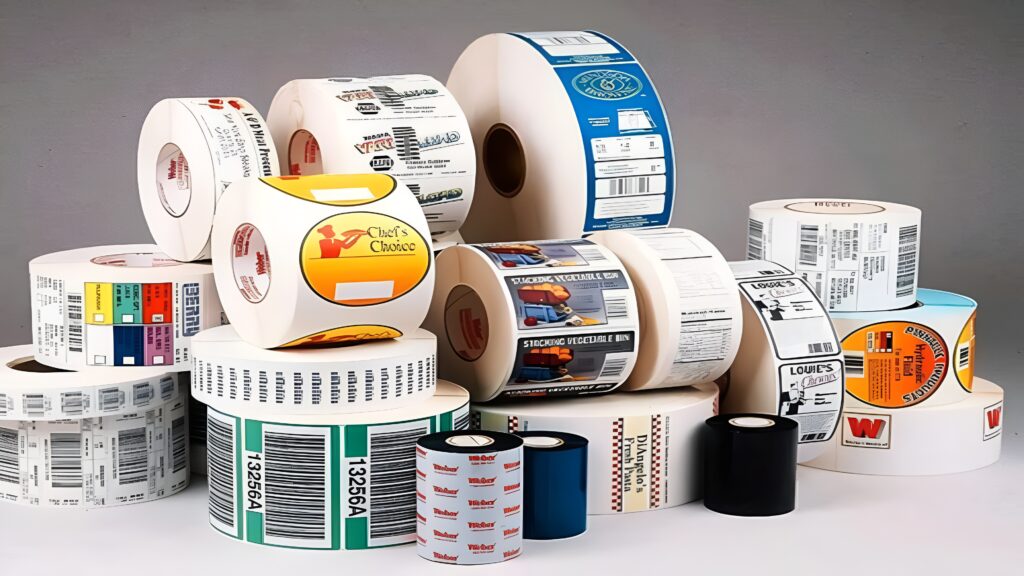Self-adhesive labels (also known as pressure-sensitive labels, sticker labels, or self-adhesive stickers) are composite materials made of face stock, adhesive, and release liner. After printing, die-cutting, and processing, they become finished label products widely used in packaging, branding, logistics, and daily consumer goods.
A standard self-adhesive label is composed of three visible parts:
- Face material (face stock)
- Adhesive
- Backing paper (release liner)
However, from a manufacturing and quality-control perspective, self-adhesive labels consist of seven structural layers, each serving a different function.
Seven Structural Components of Self-Adhesive Label Materials
1. Back Coating or Back Printing
- Back coating adds a protective layer to prevent excess adhesive from sticking to the backing paper during waste removal and rewinding.
- It also allows the production of multi-layer labels (e.g., peel-off labels, double-layer labels).
- Back printing adds logos or trademarks on the back of the release liner for anti-counterfeiting, branding, and traceability purposes.
2. Surface Coating
Surface coating improves the surface characteristics of the face stock, including:
- Increasing surface tension
- Enhancing ink adhesion
- Preventing ink smudging
- Protecting printed images from rubbing or peeling
It is especially important for non-absorbent materials such as:
- Aluminum foil
- Metallized paper
- PET, PP, PE film labels

3. Face Material (Face Stock)
This is the material on which graphics, texts, and colors are printed. It is also the part applied to the final product.
Common face materials include:
- Paper labels (art paper, coated paper, thermal paper)
- Film labels (PET, PE, PP, PVC)
- Special materials (textiles, composite foils, metalized film, rubber, flexible sheets)
Face stock must have:
- Good printing adaptability
- Proper ink receptivity
- Sufficient strength for processing (die-cutting, slitting, waste removal)
- Suitability for labeling equipment
Applications of Self-Adhesive Labels
Self-adhesive labels are used across countless industries due to easy application, strong adhesion, and versatile material choices.
Common usage scenarios include:
- Packaging labels (food, cosmetics, daily chemicals)
- Logistics & shipping labels
- Electronics & appliance labels
- Vehicle and machinery labels
- Stationery and personal items
- Promotional stickers & advertising labels
- Industrial and safety signs
The versatility of sticker labels makes them a major category in the global printing industry.
How to Remove Self-Adhesive Labels & Clean Adhesive Residue
Although self-adhesive labels adhere firmly, they can be removed with simple tools.
1. Removing the Label
- Peel off one corner of the label
- Use a hairdryer to blow warm air between the label and the surface
- Avoid excessive heat to prevent damage to the surface
- This makes removal easier but may leave adhesive residue
2. Removing Adhesive Residue (Highly Effective Method)
A practical and safe method:
- Apply a small amount of cooking oil to a cotton swab
- Allow it to soak for about 10 seconds
- Rub the adhesive residue in circular motions
- Wipe clean with a tissue
- Repeat if necessary
This method is especially effective for:
- Passports
- Metal surfaces
- Glass
- Smooth plastic surfaces
Compared to erasers or alcohol, cooking oil dissolves adhesive more gently and effectively.
Understanding Self-Adhesive Labels Helps You Choose Better Label Solutions
Self-adhesive labels are more sophisticated than they appear. Their seven structural layers ensure printability, adhesion, durability, and ease of processing. By understanding the material composition and usage scenarios, brands and manufacturers can better choose the right sticker materials, adhesive types, and printing methods for their products.


